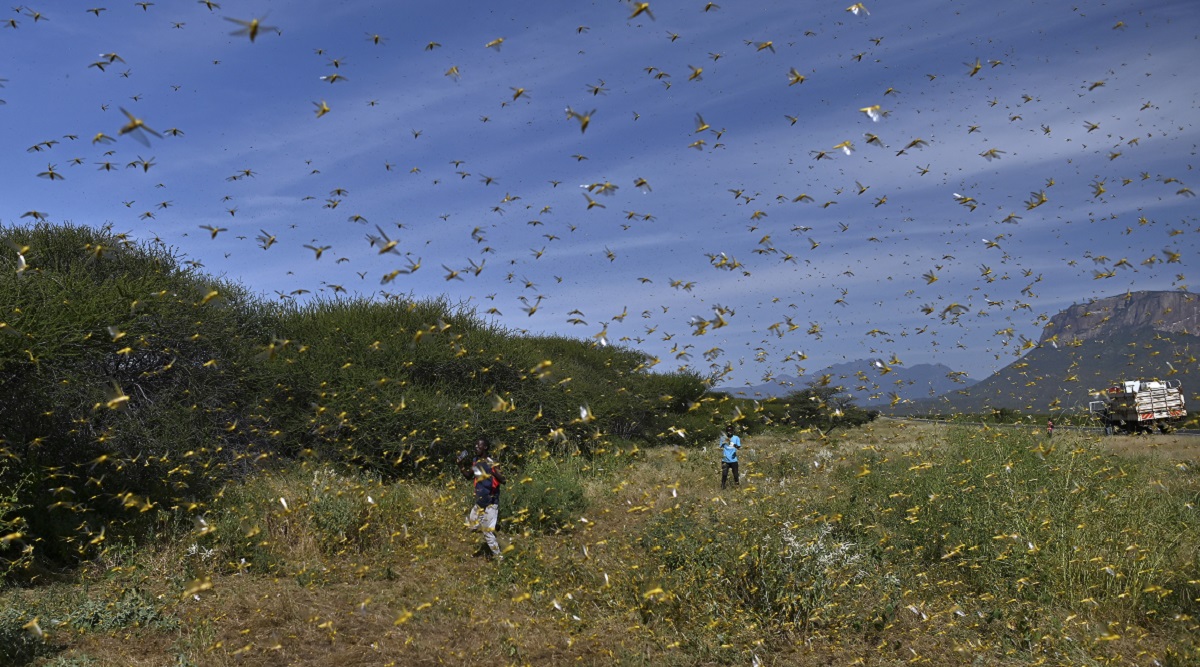Locust Attack: What Happens When This Pest Invades Farms? Know All About The Worst-Ever 'Tiddi Dal' Attack as Fear Grips Farmers in Rajasthan, Gujarat, Punjab and Other Indian States
Locusts breed in large numbers as they migrate long distances in destructive swarms, majorly from one continent to another. Locusts are not usually harmful, but in certain circumstances they become more abundant and change their behaviour, becoming gregarious. Locusts are capable of forming ‘swarms’ (adult’s congregation) and ‘hopper bands’ (nymphal congregation).

Several states in India are suffering from one of the worst locust attacks in history. Panic has gripped farmers in several states including Rajasthan, Gujarat and Punjab as they fear of a possible 'Tiddi Dal' attack which can destroy their cultivation. The Food and Agriculture Organisation (FAO) of the United Nations had in February 2020 issued a warning about twin invasion of desert locusts coming to India starting in May 2020. However, an official said that the country is prepared to meet the challenge. The FAO had stated that the world is facing one of the worst infestations of locusts in decades and that could put millions of people, especially in Africa, at risk of starvation.
This summer, a giant locust storm from the 'Horn of Africa' is expected to attack farmlands in South Asia. In India, the desert locusts have already made an entry in several districts of Rajasthan and Gujarat and are eating away everything in cultivated lands. The locusts, which are voracious eaters, have the capability to devastate major rabi (winter-sown) crops like wheat, chickpea, oil-seeds among others.
What are Locusts
Locusts are a collection of certain species of short-horned grasshoppers similar to crickets. These insects breed in large numbers as they migrate long distances in destructive swarms, majorly from one continent to another. Locusts are not usually harmful, but in certain circumstances they become more abundant and change their behaviour, becoming gregarious. Locusts are capable of forming ‘swarms’ (adult’s congregation) and ‘hopper bands’ (nymphal congregation).
Their numbers are usually low, and they do not pose a major economic threat to agriculture. However, under suitable conditions of drought followed by rapid vegetation growth, a chemical named serotonin in their brains triggers a dramatic set of changes. Karachi Battles Locust Attack: Sindh Agriculture Minister Ismail Rahu Suggests Karachiites to Make Tidi Biryani (Watch Video).
What is a Locust Attack
Due to serotonin, the chemical released in the brains of these insects, they start to breed abundantly, becoming gregarious and nomadic. Soon after, their populations become dense after which they form bands of wingless nymphs which later become swarms of winged adults which move around and rapidly strip fields and cause damage to crops. The adults are powerful fliers and can travel great distances, consuming most of the green vegetation wherever the swarm settles.
The threat from locusts continues to loom over India. In Asia, India, China and Pakistan face the most risk from these species. Pakistan has already declared an agricultural emergency on February 1 after swarms of desert locust destroyed crops on a large scale in Punjab after wiping it out in Sindh.
Destructive Power of Locusts
The destructive power of a typical locust swarm can vary from less than one square kilometre to several hundred square kilometres, says the Food and Agriculture Organisation (FAO) on its website. It can be well calculated by saying that one square kilometre swarm, containing about 40 million locusts, can in a day eat as much food as 35,000 people, assuming that each individual consumes 2.3 kg of food per day.
Situation of Locust Invasion in India
There are three zones where locust attack have been observed- Southwest Asia zone, Horn of Africa and the Red Sea zone. India, Iran and Pakistan come in the Southwest Asia zone. Locusts thrive in areas where rainfall and green vegetation are in plenty which help them breed rapidly to swell into havoc-wreaking swarms. Locusts can fly up to 150 km in a day. According to reports, oilseed, cumin and other crops across nearly 1.7 lakh hectares of farmland in India have been affected by locust swarms, which came in from Pakistan through the border areas of Rajasthan and Gujarat.
Reports state that farmers in several states including Rajasthan and Gujarat have been facing 'Tiddi Dal attacks' or locust swarms since December 2019. The locust swarms have been entering India mostly from Pakistan through Jalore and Jaisalmer in Rajasthan, and then spread across several regions. As per researchers, the standing summer crops including millet, groundnut, sweet potato among others may get damaged.
According to the United Nations, incessant rainfall and the increase in the number of cyclones sparked an unprecedented breeding and massive growth of locust populations on the Arabian peninsula in 2019. Reports inform that the 'Horn of Africa' has been called the worst-affected area. Moreover, locust swarms from Ethiopia and Somalia have travelled south to Kenya and 14 other countries in the continent. As per details by the FAO, Kenya has seen the worst locust infestation in 70 years where swarms 60 km long and 40 km wide have invaded the country's northern countries.
(The above story first appeared on LatestLY on May 08, 2020 01:46 PM IST. For more news and updates on politics, world, sports, entertainment and lifestyle, log on to our website latestly.com).



